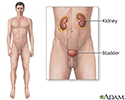RBC urine test
Red blood cells in urine; Hematuria test; Urine - red blood cells
The RBC urine test measures the number of red blood cells in a urine sample.
How the Test is Performed
A random sample of urine is collected. Random means that the sample is collected at any time either at the lab or at home. If needed, the health care provider may ask you to collect your urine at home over 24 hours . Your provider will tell you how to do this.
Collect your urine at home over 24 hour
The urine 24-hour volume test measures the amount of urine produced in a day. The amount of creatinine, protein, and other chemicals released into t...

A clean-catch urine sample is needed. The clean-catch method is used to prevent germs from the penis or vagina from getting into a urine sample. To collect your urine, the provider may give you a special clean-catch kit that contains a cleansing solution and sterile wipes. Follow instructions exactly so that the results are accurate.
Clean-catch urine sample
A clean catch is a method of collecting a urine sample to be tested. The clean-catch urine method is used to prevent germs from the penis or vagina ...
How to Prepare for the Test
No special preparation is necessary for this test.
How the Test will Feel
The test involves only normal urination. There is no discomfort.
Why the Test is Performed
This test is done as part of a urinalysis test .
Urinalysis test
Urinalysis is the physical, chemical, and microscopic examination of urine. It involves a number of tests to detect and measure various compounds th...

Normal Results
A normal result is 4 red blood cells per high power field (RBC/HPF) or less when the sample is examined under a microscope.
The example above is a common measurement for a result of this test. Normal value ranges may vary slightly among different laboratories. Some labs use different measurements or test different samples. Talk to your doctor about the meaning of your specific test result.
What Abnormal Results Mean
A higher than normal number of RBCs in the urine may be due to:
-
Kidney and other urinary tract problems, such as infection,
tumor
, or
stones
Tumor
Renal cell carcinoma is a type of kidney cancer that starts in the lining of very small tubes (tubules) in the kidney.
 ImageRead Article Now Book Mark Article
ImageRead Article Now Book Mark ArticleStones
A kidney stone is a solid mass made up of tiny crystals. One or more stones can be in the kidney or ureter at the same time.
 ImageRead Article Now Book Mark Article
ImageRead Article Now Book Mark Article -
Kidney injury
Kidney injury
Injury to the kidney and ureter is damage to the organs of the upper urinary tract.
 ImageRead Article Now Book Mark Article
ImageRead Article Now Book Mark Article - Prostate problems
- Bladder or kidney cancer
Risks
There are no risks with this test.
References
Alpers CE, Chang A. The kidney. In: Kumar V, Abbas AK, Aster JC, eds. Robbins and Cotran Pathologic Basis of Disease . 9th ed. Philadelphia, PA: Elsevier Saunders; 2015:chap 20.
Gerber GS, Brendler CB. Evaluation of the urologic patient: history, physical examination, and urinalysis. In: Wein AJ, Kavoussi LR, Novick AC, et al, eds. Campbell-Walsh Urology . 10th ed. Philadelphia, PA: Elsevier Saunders; 2012:chap 3.
McPherson RA, Ben-Ezra J. Basic examination of urine. In: McPherson RA, Pincus MR, eds. Henry's Clinical Diagnosis and Management by Laboratory Methods . 22nd ed. Philadelphia, PA: Elsevier Saunders; 2011:chap 28.
Review Date: 8/29/2015
Reviewed By: Laura J. Martin, MD, MPH, ABIM Board Certified in Internal Medicine and Hospice and Palliative Medicine, Atlanta, GA. Also reviewed by David Zieve, MD, MHA, Isla Ogilvie, PhD, and the A.D.A.M. Editorial team.

